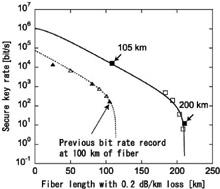Toshimori Honjo1, Kiyoshi Tamaki1, and Yoshihisa Yamamoto3
1Optical Science Laboratory, 2NIST, 3Stanford University
It is important to establish the technologies to increase key distribution
distance and key rate for realizing practical quantum key distribution
(QKD) systems. We have recently demonstrated a 200-km QKD, which set the
world record of key distribution distance, using a 10-GHz clock system
and superconducting single photon detectors (SSPD) [1].
Figure 1 shows the system configuration, in which the differential
phase shift (DPS) protocol is implemented [2]. At Alice’s site, a continuous
light is modulated into 10-GHz clock pulses using a high-speed intensity
modulator, and the phase of each pulse is randomly modulated by {0, π}. Then, the pulses are attenuated so that the average photon number per
pulse becomes 0.2, and sent to Bob through an optical fiber. Bob inputs
the pulse train into a 1-bit delayed interferometer with which he can measure
the phase differences of adjacent pulses: if the phase difference is 0
(π), the photon output from port 1 (2) and is detected by SSPD1 (2). Then,
Bob informs Alice the time instances in which he observed photons through
a conventional communication line. As a result, Alice and Bob share the
phase difference information at those time slots, which can be converted
to "keys" for one-time pad cryptography.
The working principle of the SSPD is explained as follows. When a photon
hits a current-biased superconducting NbN nanowire, it "breaks"
the superconductivity, and a macroscopic voltage pulse is generated. By
discriminating the voltage pulse, we can detect the arrival of the photon.
Although the current quantum efficiency is relatively small (about 1 %),
the SSPD has very low dark count rate (about 10 Hz), and so is suitable
for long-distance QKD. In addition, the SSPD can detect the 10-GHz clock
signal without suffering from errors due to inter-bit interference, thanks
to its good timing resolution (60 ps).
Figure 2 shows the obtained secure key rate as a function of the fiber
length. Here, the secure key rate was calculated based on a security model
considering general individual attacks [3]. We successfully distributed
secure keys over 200 km of fiber. In addition, we obtained 17-kbit/s secure
key rate at 105 km of fiber, which is two orders of magnitude larger than
the previous bit-rate record at 100 km of fiber.
This research was supported in part by CREST program of Japan Science
and Technology Agency and National Institute of Information and Communications
Technology of Japan.
[1] H. Takesue, et al., Nature Photonics 1 (2007) 343.
[2] K. Inoue, E. Waks, and Y. Yamamoto, Phys. Rev. Lett. 89 (2002) 037902.
[3] E. Waks, H. Takesue, and Y. Yamamoto, Phys. Rev. A. 73 (2006) 012344.
 |
 |
|||||
|
|